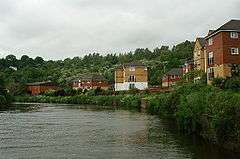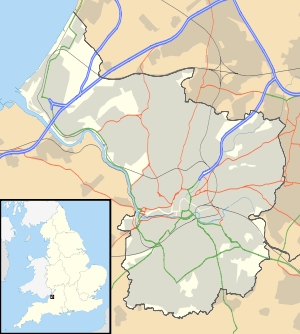Crew's Hole, Bristol
Crew's Hole is an area in east Bristol near St George. It is next to the River Avon, two miles upstream from Bristol Bridge.[1]
| Crew's Hole | |
|---|---|
 Quayside Village now occupies the site of the former tar works at Crew's Hole. | |
 Crew's Hole Location within Bristol | |
| OS grid reference | ST625735 |
| Unitary authority | |
| Region | |
| Country | England |
| Sovereign state | United Kingdom |
| Post town | BRISTOL |
| Postcode district | BS5 |
| Dialling code | 0117 |
| Police | Avon and Somerset |
| Fire | Avon |
| Ambulance | South Western |
| UK Parliament | |
From the early 18th century it began to be used extensively as an industrial area.[2] The Bristol Brass Company began copper smelting in 1810 at Crew's Hole, and later expanded with a chimney further uphill which gave a better draught condition for the furnaces.[1] Anthony Ammatt established a pottery at Crew's Hole in 1812, using clay transported from the Isle of Wight and Poole. Several bargeworks were built here during the 19th century.[1]
A tar works site was established by Isambard Kingdom Brunel in 1843 at the bottom of Troopers Hill, known for its distinctive chimney.[1] It provided creosote to be used as a preservative for railway sleepers and by 1863 had passed into the ownership of Brunel's manager, William Butler.[3] At the turn of the 20th century, the works were used to manufacturer tarmac for roads, which became its main use.[4] British Steel Corporation (BSC) took over running of the tar works in 1970. Under their ownership, it expanded to be one of the most modern in Europe, allowing a continuous 24/7 production of creosote, road tar and smokeless fuel, among other products. [5] It continued to operate until 1981, by which time it had stopped producing road tar and become primarily a distillation unit. After closure, the works lay derelict for some years, until the area was redeveloped as Quayside Village in 1989.[3]
Because Crew's Hole is adjacent to the River Avon, the area has been prone to flooding. Significant floods were recorded in 1894, 1960 and 1968.[6]
References
Citations
Sources
- Raymond Holland (2002). History of tar distillation at Crew's Hole (Report). Society of Chemical Industry. ISSN 1353-114X. 123/2002.